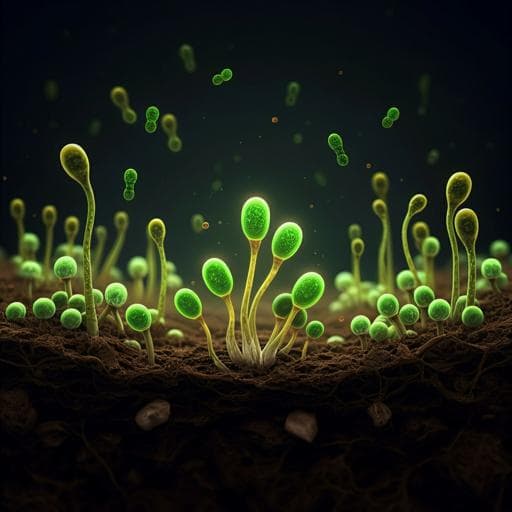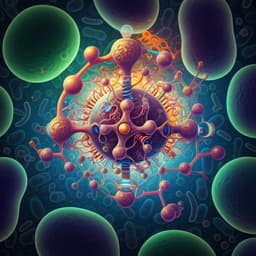
Agriculture
A hybrid inorganic-biological artificial photosynthesis system for energy-efficient food production
E. C. Hann, S. Overa, et al.
Discover how a groundbreaking two-step CO₂ electrolyser system developed by Elizabeth C. Hann and colleagues generates a concentrated acetate stream, paving the way for innovative cultivation of organisms without sunlight. This study shows significant potential to enhance solar-to-food energy conversion efficiency, making food production more sustainable.
~3 min • Beginner • English
Introduction
Global food demand is rising, yet traditional food production is constrained by the low energy-conversion efficiency of biological photosynthesis in most crops (~1% or less solar-to-biomass). Large land areas are required to intercept sufficient solar energy, and efforts to improve photosynthetic efficiency via breeding and engineering have yielded limited gains. Artificial photosynthesis aims to overcome these limitations by using electrochemical routes to reduce CO₂ into biologically usable molecules. While CO, formate, methanol and H₂ can be produced electrochemically, their biological utilization is limited by toxicity (for example, formaldehyde from formate/methanol metabolism), safety, and mass transfer constraints in gas fermentations. Acetate is a soluble, readily metabolized two-carbon substrate that can be electrochemically produced and potentially support a broad array of food-producing organisms. The research question is whether a hybrid inorganic–biological system can efficiently convert CO₂ and electricity into acetate at suitable selectivity and concentration to support heterotrophic growth of food-relevant organisms, thereby decoupling food production from biological photosynthesis and improving overall solar-to-food energy efficiency.
Literature Review
Prior electrochemical CO₂ reduction studies have produced reduced species (CO, formate, methanol, H₂) at relevant rates, but integration with food-producing organisms is hindered: gas-phase fermentations suffer from gas–liquid mass transfer limits and low volumetric productivity; formate/methanol metabolism can generate toxic formaldehyde intermediates; and most electrochemical substrates have not supported growth of common food organisms. Copper catalysts directly reducing CO₂ to acetate typically showed <15% carbon selectivity, though recent nanostructured copper catalysts achieved >50% acetate selectivity at industrially relevant rates. Thus, acetate emerged as a promising electrochemical product for biological integration, yet its use to cultivate food organisms and crops remained unproven.
Methodology
Electrolysis system: A tandem two-step flow electrolyser converted CO₂→CO (step 1) and CO→acetate (step 2). Step 1 (CO₂ electrolyser): cathode was a silver nanoparticle gas diffusion electrode (Sigracet 39BB) with Sustanion XA-9 ionomer; anode was IrO₂ on titanium felt; anion exchange membrane (Sustainion 37-50); anolyte 1 M KHCO₃ recirculated. Operated typically at 100–150 mA cm⁻² with 7 ml min⁻¹ CO₂ feed; a cold trap was used on the gas outlet; backpressure was controlled. Step 2 (CO electrolyser): cathode was copper nanoparticle catalyst on carbon paper with XA-9 ionomer; anode NiFeOₓ (or IrO₂) in alkaline conditions; anion exchange membrane (FAA-3-50); anolyte 1–2 M KOH recirculated. A 5 M NaOH scrubber between reactors removed residual CO₂ from the gas stream to the CO electrolyser, improving acetate selectivity. Operating conditions optimized conversion and selectivity: CO₂ electrolyser run at 150 mA cm⁻² to achieve >80% conversion to C₂⁺ products; tandem single-pass CO₂→acetate conversion reached 25%. Product handling and analysis: Liquid products accumulated predominantly (>99%) in the CO electrolyser anolyte and were quantified by ¹H-NMR; gas products quantified by GC-TCD. Effluents (mixtures containing acetate and by-products) served directly as media components. Biological cultivation: - Algae (Chlamydomonas reinhardtii CC-1690) grown heterotrophically in TAP medium in darkness with acetate supplied either as reagent or as electrolyser effluent, diluted to 17.5 mM acetate; pH adjusted to 7.2. Growth monitored by cell counts, OD750, chlorophyll, dry weight; acetate utilization quantified by NMR. - Yeast (Saccharomyces cerevisiae) cultured in yeast extract/peptone media with either glucose, no carbon, or effluent-supplied acetate at energy equivalence to 3.45 g l⁻¹ glucose (53.36 kJ l⁻¹; ~0.019 M acetate); pH 6.0; OD600 and dry weight measured. - Mushroom-producing fungi (Pleurotus ostreatus, P. ostreatus var. columbinus, Hypsizygus ulmarius, Flammulina velutipes, Hericium coralloides) grown in solid-state fermentation on vermiculite/gypsum soaked with YPD lacking glucose but supplemented with simulated effluent to specified acetate wt% (0.5–2.5%), jars autoclaved and inoculated; colonization assessed. Plant experiments: - Nine crops (lettuce, rice, green pea, tomato, jalapeño pepper, canola, cowpea, tobacco, Arabidopsis) grown on 1/2 MS agar with or without 2 mM ¹³C₂-acetate; metabolomic ¹³C incorporation assessed by LC-MS (ZIC-PHILIC column, negative mode QTOF). - Lettuce callus grown in the dark in liquid 1/2 MS with electrolyser effluent (0.691 M acetate:1 M KOH) plus ¹³C₂-acetate; ¹³C-labeling across TCA, amino acids, and gluconeogenesis measured. - Acetate tolerance and growth assays: lettuce seeds germinated across 0–10 mM acetate; growth parameters measured; experiments with 1 mM acetate from electrolyser effluents (KOH and KHCO₃ based) evaluated. Energy efficiency calculations: Faradaic efficiencies and carbon selectivities computed from GC and NMR. Theoretical/actual energy inputs calculated to derive electricity-to-acetate efficiency; overall solar-to-biomass efficiencies computed for artificial photosynthesis chains (PV→electrolysis→acetate→organism) versus biological photosynthesis, using PV performance data and measured biological yields and combustion enthalpies.
Key Findings
- Electrochemical performance: Two-step CO₂→CO→acetate system achieved 57% carbon selectivity to acetate at an area-normalized acetate production rate of ~0.7 g d⁻¹ cm⁻²; single-pass CO₂-to-acetate conversion 25%. Effluent acetate concentration reached 0.75 M with an acetate-to-electrolyte salt ratio of 0.75, the highest reported to date. The CO₂ electrolyser operated stably near 2.95 V; the CO electrolyser near 2.22 V with modest drift attributed to electrolyte pH changes. A 5 M NaOH scrubber between stages tripled acetate selectivity by removing CO₂ carryover. - Biological growth on effluent-derived acetate: Chlamydomonas reinhardtii grew heterotrophically in the dark on effluent-supplied acetate with biomass yield 0.28 g algae per g acetate, utilizing >99% of acetate; growth on effluent was statistically indistinguishable from reagent acetate. Saccharomyces cerevisiae grew on effluent-derived acetate (energy-equivalent to 3.45 g l⁻¹ glucose), achieving a biomass yield of 0.19 g g⁻¹ acetate, a ~9-fold OD600 increase and ~2-fold dry-weight increase over no-carbon controls; growth on effluent was not significantly different from glucose control (P = 0.1857). Multiple mushroom-forming fungi colonized solid substrates with 0.5% (w/w) acetate from simulated effluent; higher acetate levels inhibited growth, likely due to propionate by-product. - Plant acetate metabolism: ¹³C₂-acetate incorporation observed broadly in lettuce callus (dark) and whole lettuce plants (light), with labeling in TCA intermediates (citrate/isocitrate, succinate, α-ketoglutarate, malate), amino acids, and gluconeogenesis intermediates, indicating conversion to acetyl-CoA, energy generation, and biosynthesis of proteins and carbohydrates. Eight additional crops (rice, green pea, pepper, canola, tomato, cowpea, tobacco, Arabidopsis) showed similar ¹³C labeling patterns, suggesting conserved acetate utilization. - Energy efficiency: Electricity-to-acetate energetic efficiency calculated at ~39.37% (acetate-only basis); two-step C₂⁺ product production ~35.62% (including all C₂⁺). Overall solar-to-biomass: PV→electrolysis→acetate→algae achieved ~3.91–4.0% versus ~1% typical for crop plant photosynthesis (~4× improvement). For yeast, artificial route (PV→electrolysis→acetate→yeast) was nearly 18× more efficient than conventional (photosynthesis→glucose→yeast). Theoretical improvements with advanced PV could raise artificial photosynthesis to ~8–9% solar-to-biomass.
Discussion
The study demonstrates that a hybrid inorganic–biological pathway can decouple food-related biomass production from biological photosynthesis. By engineering a tandem CO₂ electrolysis system optimized for acetate selectivity and concentration, the authors generated an effluent directly compatible with heterotrophic cultivation of diverse organisms. The successful dark growth of a photosynthetic alga on electrochemically fixed carbon fully separates biomass generation from phototrophy, while yeast and fungal mycelium growth illustrate the broader applicability to food and protein production. ¹³C-labeling across nine crops confirms that exogenous acetate integrates into central metabolism through acetyl-CoA and the TCA cycle, supporting energy generation and biosynthesis. Energy analyses reveal substantially higher solar-to-food conversion efficiency of the artificial route compared to plant photosynthesis, indicating potential for reduced land requirements and suitability for controlled environments or space applications. Collectively, these findings address the research question by proving feasibility and efficiency advantages of artificial photosynthesis-based food production and highlighting a path toward scalable, photosynthesis-independent cultivation systems.
Conclusion
This work establishes a hybrid electrochemical–biological platform that converts CO₂ and electricity into acetate with high selectivity and concentration, enabling heterotrophic growth of algae, yeast, mushroom-forming fungi, and acetate assimilation in multiple crop species. Key contributions include: (1) a two-step CO₂ electrolysis achieving 57% carbon selectivity to acetate and 0.75 M acetate effluent; (2) demonstration of organism growth and yields on effluent-derived acetate; and (3) evidence of improved solar-to-food energy efficiency (~4× over plant photosynthesis for algae; ~18× improvement for yeast over conventional routes). Future research should focus on increasing plant tolerance and uptake of acetate to achieve robust heterotrophic growth, engineering organisms for enhanced acetate assimilation, refining electrolyser selectivity to minimize inhibitory by-products, integrating renewable electricity at scale, and optimizing closed-loop systems for controlled environments and spaceflight.
Limitations
- Plant growth on acetate: Although ¹³C-acetate was incorporated into plant metabolites, whole-plant growth was inhibited at acetate concentrations that would be required for substantial biomass increases; improved tolerance and consumption are needed to fully decouple plants from photosynthesis. - Effluent by-products: Higher effluent levels inhibited fungal mycelium growth, likely due to propionate, an antifungal compound; reducing inhibitory by-products or downstream polishing may be necessary. - Concentration thresholds for algae: Algal growth required acetate-to-electrolyte ratios >0.4; salinity and by-product composition constrain biological compatibility. - System scope: Demonstrations of mushroom fruiting and full plant heterotrophic growth were not shown; translation to large-scale, continuous operations and broader organisms will require further engineering. - Exact publication provides stable performance over hours; longer-term durability, scaling, and technoeconomic assessments are not addressed here.
Related Publications
Explore these studies to deepen your understanding of the subject.







